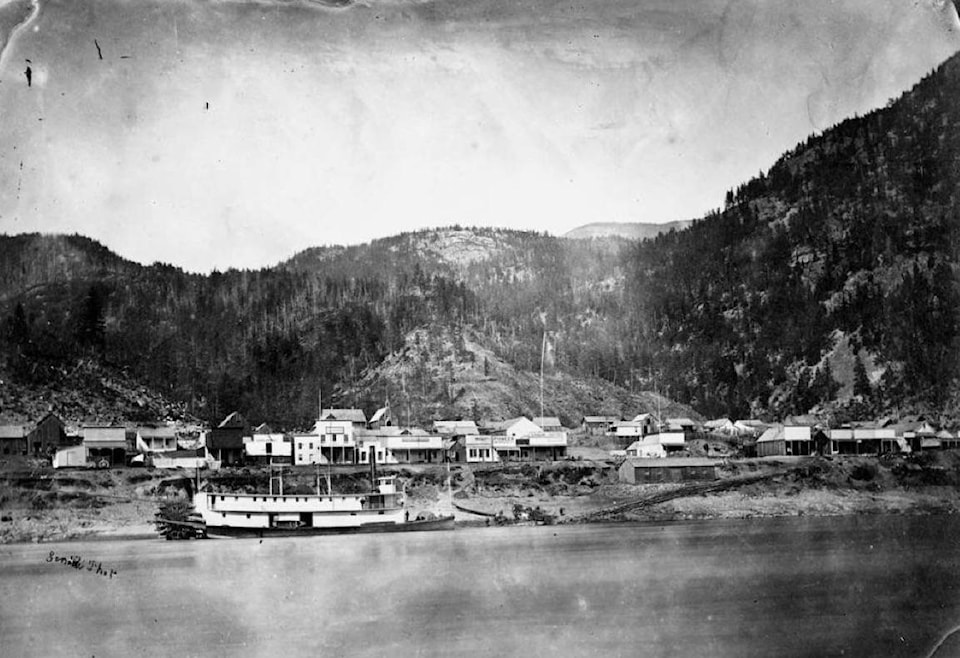Most people passing through Yale today would probably have a hard time believing that the town—which according to the 2016 census now has a population of 143—was once one of the most populated spots in the Interior of B.C.; a bustling town long before Vancouver was established, boasting restaurants, hotels, and shops that catered to residents, as well as the thousands of people who passed through.
The boom was, of course, sparked by gold fever. While various theories have been floated as to who first realized that there was gold along the banks of the Fraser and Thompson Rivers, and when they realized it, the most widespread story is that a First Nations man found gold nuggets near the mouth of the Nicomen River in 1856. This came to the attention of the Hudson’s Bay Company (HBC), and soon they were encouraging First Nations people to find, and sell them, as much gold as they could.
Although the HBC tried to keep things quiet, word began to spread that there was gold to be found; not only at Nicomen, but all along the Fraser and Thompson. The California gold rush of the late 1840s had ended, and by the fall of 1857 a steady stream of miners had started arriving in the British colony. News of even richer deposits above what would soon become the town of Lytton began circulating, and only the onset of winter prevented an even greater number of people descending on the region.
By February 1858 the HBC had accumulated 800 ounces of gold, which was shipped to the closest mint, located in San Francisco. The mint’s superintendent was a member of the San Francisco Volunteer Fire Department, and at a firefighters’ meeting shortly after the gold arrived he told his colleagues, “Boys, the next excitement will be on the Fraser River.”
A small party of miners set out from San Francisco to explore the area, and quickly found gold around what was then called Fort Yale. Word of this and other discoveries was all it took to rekindle gold fever in the would-be millionaires who had flocked to California, only to be disappointed; and within months some 30,000 people had stampeded north to what would, as of November 19, 1858, be known as the colony of British Columbia.
Fort Yale was an HBC post, and per company tradition was prefaced with the word “Fort”, although it had neither a stockade nor bastions. Established in 1847, it was named after James Murray Yale, the officer in charge at the HBC’s Fort Langley (the site’s previous English name had been “The Falls”, after the rapids upstream from it; the Halkomelem First Nation name for the site translated to “Short-leaved willow trees” after the Sitka willow).
The fort did not last long; within a short time it had been abandoned in favour of Fort Hope. However, when miners began flooding into the area, the site of the fort provided a natural settling place for many, who staked out spots wherever there was enough room for them to lie down, and slept rough—some in tents, some not—until such time as they could put together a more permanent shelter.
As has been noted in this column before, many of those who came to British Columbia because of the gold rush soon realized there was almost certainly more money to be made by catering to the miners than by being one. An enterprising American named Thomas Yorke established the first roadhouse in Yale in July 1858. An article in the British Columbia Gazette on July 25, 1858 does not paint an appetizing picture of the establishment:
“There is but one public eating house in the town, and invariably the diet is bacon, salmon, bread, tea and coffee … the charge is $1.00 a meal [about $27 today]. No milk or butter is ever seen. It is kept in a miserable log hut partly barked over, and with a dirt floor. Everything is done in the same room—which is no more than 12’ X 14’ and consequently cramped for space, and as hot as on oven… . At night miners sleep on the floor before a roaring fire at one end of the room.”
For a roadhouse to be superior to Yorke’s House seems a fairly low bar to clear; and later in 1858 Capt. William Power, a well-respected young Irishman, and his German wife opened a hotel and restaurant in Yale. It soon came to be regarded as the best such establishment in town, and was apparently much appreciatede. By 1862 two more roadhouses—California House and the Colonial Hotel—had been built in Yale.
The journalist who wrote about Yorke’s House had kinder words for the town itself: “There are about 700 or 800 people here, nearly all of whom are miners living in canvas tents, waiting for the river to fall. There are five or six log houses in the place, and the inhabitants are orderly and everything is peaceable and quiet.”
His estimate of the population of Yale at that time is one of several such estimates of the area’s population, which diverge wildly. One writer claims that by late 1858 there were 3,000 miners working the 15-mile stretch of river between Hope and Yale; another claims there were 15,000. Another writer who arrived in Yale in July 1858 estimated that “the town of Yale must have contained at that time between five and six thousand people, mostly enterprising young miners and business men from California, who had come in pursuit of the Golden Butterfly, which most of its devotees and admirers in the result found both elusive and disappointing.”
The writer of these words was 24-year-old David Williams Higgins, who has left us with the most vivid descriptions of Yale at the start of the gold rush. We will hear more from him in the next installment.
editorial@accjournal.ca
Like us on Facebook and follow us on Twitter
